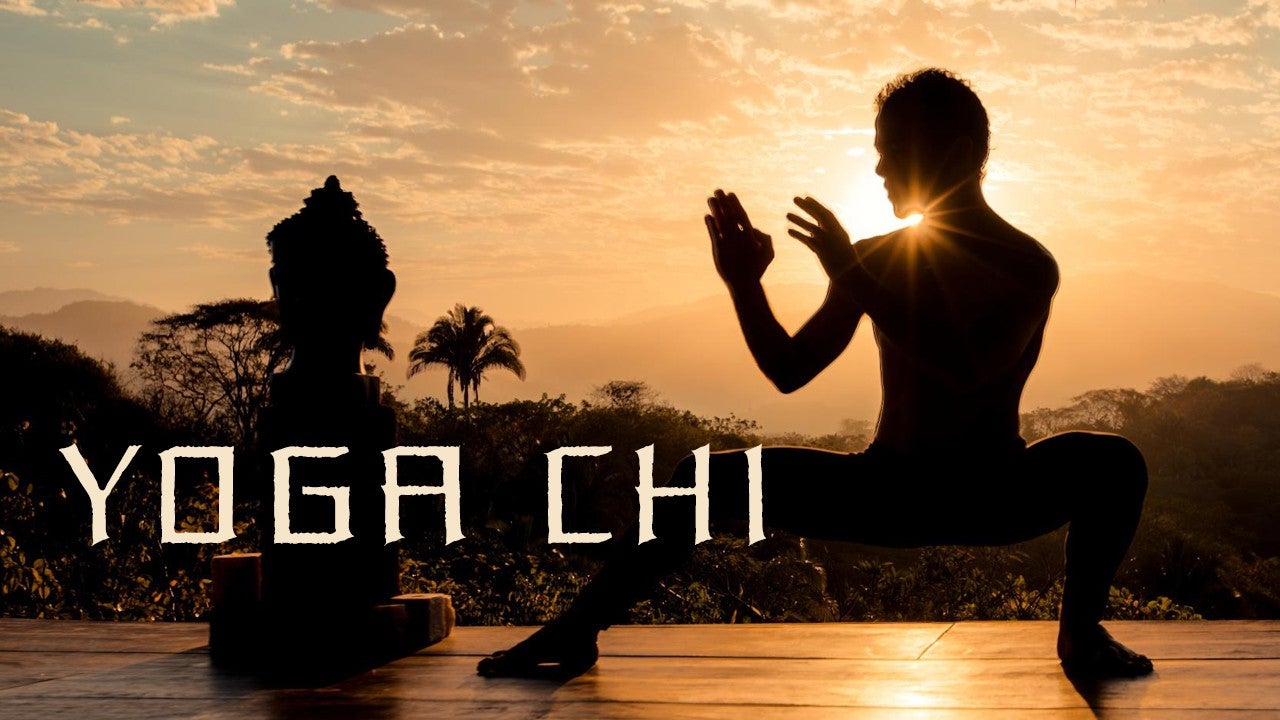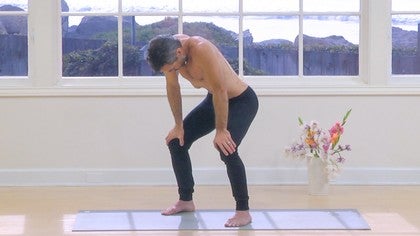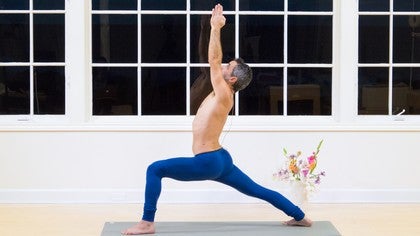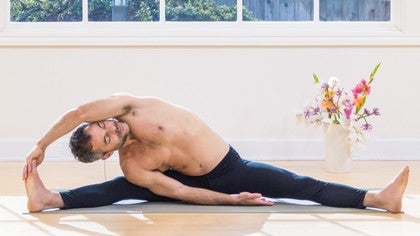Description
About This Video
Transcript
Read Full Transcript
Welcome. In this episode I'm going to share the art of Udayana Bandha and how to apply and integrate this powerful yoga technique into your daily practice. Before we begin I need to give a brief overview on this technique. What it means, its health benefits, and how it can enhance and deepen your daily practice. Traditionally Udayana Bandha is the first lock that is taught. Udayana means flying up and it's important to know what's actually flying up. Traditionally the term flying up actually was referring to the energetic force that lies dormant at the base of the spine known as kundalini. So when I teach this I actually don't teach to take the organs in and up or the abdominal wall in and up. When I teach this I teach just the abdomen draws back. Over time as you awaken this center there's a natural energetic force again that's referred to as kundalini that naturally awakens and that's what flies up. If you pull the abdomen too forcefully in and up it actually can send too much excessive pressure into the heart, the head, the breathing diaphragm, and one of the arts of the yoga is to actually heat the body up without overheating the head. The term hatha yoga refers to the Sun and Moon.
The Sun on the body is the solar plexus, solar Sun, and this is our heating mechanism center of the body and so the Udayana Bandha is a wonderful way to heat the body up internally. The brain represents the Moon and they say in the internal arts that the body should heat up but the head should stay cool. So if the navel is drawn excessively up physically it's very easy to send excessive heat up into the head. The nature of fire is that it rises up in the eyes, the ears, the nose, the mouth, or like vents. So it's very easy to stoke your fire and have the fire rise up excessively to the head. Ideally as we build the heat from our solar plexus the energy radiates equally in all directions. So we feed the heat to the feet, through the legs down to the feet, through the spine out into the arms. We feed just the right amount of heat to the head but it's not excessive. The idea is to illuminate the brain but not to heat it and physiologically the brain is the most susceptible organ to heat. So when I teach this it's very important that you just draw the navel back and not up. A couple tips if you find that you're building excessive heat up in the head there's a couple tips that I like to teach. One is actually a Bandha known as Jiva Bandha and that's where the tongue lightly touches the upper palate. It's also termed Nabho Mudra. Mudra means seal and it's basically a way of sealing the energy in the body that runs from the base of the spine up to the top of the head and back down the spine. So tongue to the upper palate acts as a bridge to keep that energy circulating up and back down. Other tips when you're breathing the breath the sound of the breath that's an Ujjayi breath and the breath sound comes from the narrowing of the base of the throat and the sound actually resonates between the heart and the base of the throat. So we're not breathing forcefully through the nose we're not creating any sound through the nose. Sound equals friction and friction builds heat in the head. The gaze should be soft if we start to get too forceful with the eyes the eyes are related to the fire element and it's very easy to have heat sent up to the head. So again that's another technique the softness of the gaze not breathing excessively although we're breathing through the nose not creating any sound through the nose tongue to the palate and lastly learning how to apply just the right Jallandara Bandha. This is the Bandha that lies at the throat where the chin draws in slightly. If we are in our positions and we're lifting excessively from the chin up it sends the heat up to the head. So as you see in this first exercise that I'm showing known as the Udayana Bandha Kriya squat the chin is going to draw in towards the throat and this is going to help prevent the heat going from the navel up into the head excessively. These are important points. The contraindications in this include you should have an empty stomach this is done on an empty stomach and ideally it's done in the morning time but it can be done later in the day but make sure you have at least three hours between your last meal and applying Udayana Bandha. The other contraindications are for women if you're on your men's cycle it's not recommended to take this lock. High blood pressure, hiatal hernia is another indication where you don't want to apply this lock. The hiatal hernia is where the stomach gets pulled up into the breathing diaphragm and that excessive drawing up of the navel in and up can actually create a hiatal hernia and that's another reason why I'm so big on just taking the abdomen back and not up. So before we begin the last thing I want to share is Udayana Bandha is a lock where you draw the navel to the spine. It's important to actually before you just draw the navel to the spine it's important to learn how to soften the organs. A lot of times when we were given the direction Udayana Bandha we just sucked the navel in and we're just packing tension on top of tension. So this first technique I'm going to share with you the Udayana Bandha squat sequence is first going to teach you how to actually soften the organs before you apply the navel lock. It's termed a reverse breath breathing exercise so you're going to see as I'm exhaling into this squat I'm actually going to be releasing my navel out and then when I'm empty I'll draw the navel back in. Natural breathing the navel expands on the inhale and on the exhale the navel contracts. You're going to notice that on the exhale in this position initially the navel will relax with the exhale and this is designed to release any tension in the breathing diaphragm and in the organs. The health benefits that come with Udayana Bandha it's wonderful for the organs it's wonderful flushing the lymph it's great for the kidneys the adrenals so there's a many many physical health benefits. It helps also to release emotional and of what we call psychic emotional mental blockages in the body because we see in the internal arts the Chinese and the Ayurvedic systems the emotional body lies within the organs so when the organs are healthy the emotional body is healthy. So I'm going to begin with this first squat the feet are slightly wider than hip width apart they're parallel exhale fully and as you take the arms out and up it's very light inhale take the arms up a little force palms turn down now as you exhale simply bend from the back of the knees as you exhale the hands are gonna land on the thighs and you're gonna relax the lower abdomen without collapsing in the lower spine that's key you're not collapsing in the lower spine you look into the navel you've exhaled fully and then on empty without drawing an in-breath in you're empty draw the lower abdomen back towards the spine when you come up you don't just let the navel spill forward it's like you got an invisible belt and you release the navel just halfway and then you come up so it's like a half a udiana and you receive the in-breath as I'm reaching up my focus is on the navel I'm breathing down to the navel and inhaling and then as I exhale the hands come down in from the back of the knees soften the abdomen relax the abdomen exhale it'll feel like your shoulders are up at the ears but it's just your shoulder girdle it's okay you want to have a connection from the heel all the way up to your shoulders it's like one bone from the heel to the shoulders this will allow you to relax the organs more and then on empty udiana navel back again as you come out release the lock just halfway inhale relax the shoulders palms turn down exhale make your way in exhale exhale the more you can exhale soften the abdomen the deeper the Bandha look into the navel the eyes will help trigger the lower abdomen back udiana on empty rise up release the navel just slightly shoulders relaxed inhale exhale down exhale exhale look into the navel udiana navel back rise up and do three more rounds inhale long exhale all the way down exhale completely exhale completely look in udiana rise up shoulders relaxed inhale exhale down look in udiana draw back without breathing and one more time inhale receive the in-breath drop the shoulders the arms are light inhale pause exhale slowly going exhale exhale udiana and then inhale up and grounding keep the legs straight exhale hands down head level so from here I want to share how to apply this Bandha and the other Asanas the first few movements I'm going to do I want to really focus on my lower abdomen and how it moves back and I'm going to show just a basic Sun salutation Surim namaskar a and I'll show how to apply the Bandha in Samastiti or also known as Tadasana and then I'm gonna do a forward bend and just notice my navel so as I turn I'm gonna bring my feet together as I make my way to set up for the Sun salutation what I don't want is I don't want to just let my belly hang and then what happens here is the lower back falls in and I'll compress the space between them the lumbar spine what I'm doing is very gently drawing the navel back it's very subtle it's a very slight drawback and that'll pull me onto my center point I again want to avoid excessively drawing in and up it'll start to puff the ribs and it'll take a lot of my awareness away from my center so it's really less is more here it is very gently draw the lower abdomen back just slightly and then inhale down into that space without bloating the abdomen you're credit creating just the right amount of pressure into the body through the breath then exhale and I'm still holding the Bandha as I'm inhaling although my awareness might be going up to the hands I'm inhaling through the body all the way down through the navel all the way to the soles of the feet inhale this will root me to the earth now as I exhale I bring the hands down the center line and watch my navel my navel guides me in as I exhale my navel starts to draw back I exhale fully in I want to show this one more time as you inhale up if you haven't cultivated this awareness a lot of time especially in the beginning of learning this practice sometimes we'll go in and we'll just fold and this will stay inactive we'll just kind of fold and it'll we stay stuck we won't get into the legs and we kind of start to force our way into the pose just watch my navel all I do is I draw my navel back I don't have to pull I just draw my navel back I draw my navel back and it takes me in to the forward bend and once the organs get out of the way it'll create more opening in the backs of the legs this entire sheet that runs the backs of legs through the sacrum all the way to the top of the head will start to release in a really nice way and it's really safe for the body so one more time I apply a gentle udiana at the lower abdomen the arms come up I inhale down to that space into the lower abdomen I like to keep the hands close to the body remind me to fold and to move from my center exhale navel back exhale keep exhaling the outcome is a gentle udiana and fold as you inhale the knees bend I'll just take you through it's a simple salutation step back now here the Bandha is applied you're not just falling in on the lower abdomen you would draw the navel back slightly this will help reinforce the hands and it makes space in the mid-back the thoracic spine and as you exhale we'll go down into Chaturanga maintain the Bandha it's very gentle the knees can touch onto the tops of the feet inhale up now as we pull back this is key take the weight into the palms let your navel pull you back let your navel pull you back as you're exhaling follow my navel the navel draws back and the outcome of that exhale is udiana bandha and then as I inhale I initiate the inhale from my palms I know we're breathing through the nose but I want to feel like I'm breathing through my palms to the navel and fill the navel and as you exhale the navel draws back udiana and this udiana the navel draws back and you actually send it if anything you send your awareness more towards the pelvic floor into the legs and this will feed your legs let's take one more breath here inhale and exhale navel draws back and you're empty lengthen the waist feed the legs thighs back thigh bones back and then I'm gonna release and I just want to share something here when you're doing a vinyasa practice and you're moving and you're building a lot of heat and you start to lose control your breath one of the benefits of udiana bandha is it'll actually it acts as a braking system it'll teach you how to control the breath how to harness the breath when the breath gets erratic when it gets kind of out of control and you're feeling like you're huffing and puffing the bandha is designed to help slow the breath down so for an example I pull back I've been doing a pretty intense practice and I'm starting to lose my breath the navel you might find if there's excessive force in the through the nose again it'll build a little too much heat in the head and the navel start to kind of disengage and you'll start to huff and puff more from the head you want to reverse that and get it down into the lower abdomen so I'm a little out of control and then I'm just gonna apply the bandha I go I have my udiana I'm gonna exhale I'm gonna focus on my navel then I'm just gonna slow the breath down inhale and exhale that's key because in yoga what separates yoga from just any other exercise is the control of our breath the idea of a skillful yoga practice is not to waste one breath each breath should lead should be accounted for and should be kind of fully conscious of each breath and then it'll really take you in a nice space it takes you out of just the physical body and it takes you more into a meditative state it's actually very healing for the body it's very healing for the nervous system and we can slow the breath down when the main benefits of yoga and other healing modalities like acupuncture massage is it's designed to shift you into the parasympathetic nervous system when we're taking care of our daily kind of business we're on the go the sympathetic nervous system is in charge it becomes dominant it has its place it's when the adrenals are firing and again it's especially nowadays it tends to kind of become dominant we get stuck in that sympathetic wheel because we have so much stimuli coming out of us one of the most therapeutic things we can do on our own to help heal and keep ourselves in balance is making space where we train the nervous system to shift into what we call the parasympathetic mode slowing the breathing down does that and that's one of the main benefits for the nervous system that udiyana bandha will provide you it also teaches you about the four stages of the breath in yoga it's not just inhale and exhale it's actually inhale retention exhale retention so there's four stages inhale and then there's an inhale where you hold the breath exhale and then after the exhale where we apply the udiyana bandha we pause they found out through it's been studied in the recent years why are the yogis doing this breath retention what's behind it and what we found out is that if you can cut the breath off and you can make space between the breaths you can actually it's very beneficial for the brain what they've discovered is it actually sends a boost of oxygen to the brain when we can we can basically make that space between the breaths in a very calm state and the brain is the most important and the master organ of the body and when the brain is kind of cut off from oxygen just for a few seconds it says hey don't forget about me and what they've discovered is boost of oxygen are being sent to the brain so the idea is we're oxygenating the brain if we can stay calm so that's another key the benefit of this bandha lastly I'm going to show you I'm just going to show a seated forward fold and I'm going to make my way from down dog I've exhaled fully I apply the bandha come through I'm going to straighten the legs into the seated forward forward fold and his poshimottanasana now again as I showed in the standing forward fold I'm just going to demonstrate it from a seated position it's very easy if we haven't been trained to not engage the lower abdomen and it's quite common in a class where we'll go in we'll grab the toes and we'll just forcefully pull with the arms and we'll get aggressive with it and the abdomen will just kind of stay asleep basically what we want to do through the training of our udiana preparatory exercises as we get more and more awareness in this area we want to allow the navel to take us in as you see as I go into this forward bend I don't even have to pull with my arms if I can draw the navel back as soon as I start to draw the navel back my thigh bones ground my base is set my navel takes me in I don't have to pull my navel takes me in my navel takes me in as opposed to not engaging this area where we start to get more into a struggle you'll find when the organs can pull back you'll actually get a deeper opening in the back of the legs you'll start to open up the leg lines the calves the hamstrings so the outcome of the exhale is udiana bandha in most awesomeness I invite you to integrate this into your practice it can be a really transformative technique I hope you enjoyed this namaste
Yoga Chi
Comments
You need to be a subscriber to post a comment.
Please Log In or Create an Account to start your free trial.






















